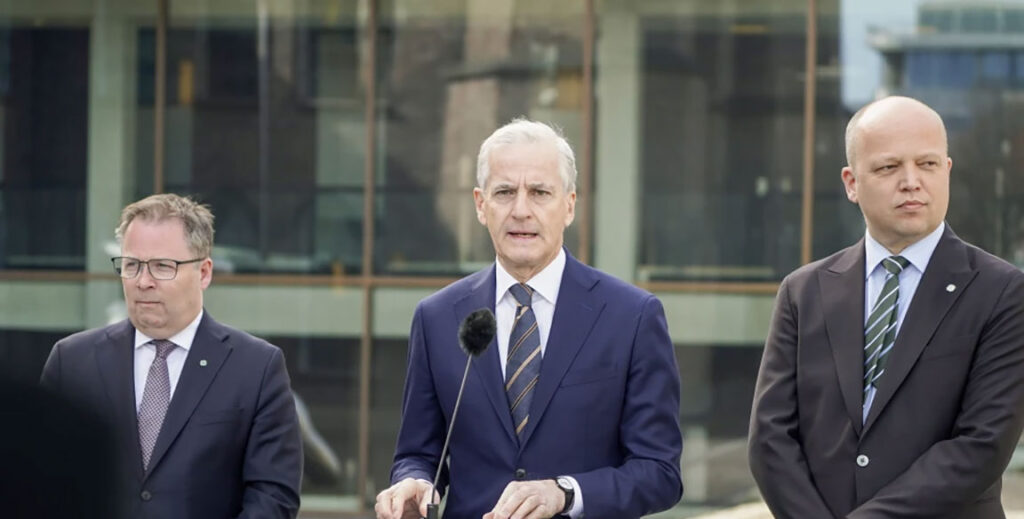Norwegian Defence Minister Bjørn Arild Gram, from left, Prime Minister Jonas Gahr Støre and Finance Minister Trygve Slagsvold Vedum take part in a news conference to discuss increased defense spending. THE ASSOCIATED PRESS
THE WATCH STAFF
The Norwegian government announced another large defense spending increase in May 2024 that will bring the Nordic country in line with NATO’s goal of member states spending 2% of GDP on defense before the NATO summit in July. Prime Minister Jonas Støre explained the mid-year budget spike as necessary because of increased tensions in the region. “We must increase the operational capability of the Armed Forces,” Støre said at a news conference announcing an additional $630 million to the defense budget over the next 12 years – only a month after the country approved a historic bump in military spending.
In April 2024, Norway released its 12-year defense plan, which called for doubling the defense budget by 2036. Increasing the Army from one to three brigades and expanding the Home Guard to 45,000 soldiers were among the major changes announced. The plan also envisions new frigates, submarines and other vessels, as well as Norway’s first long-range air defense system, according to a government news release.
“As our security environment is deteriorating, we need to spend more on and pay more attention to defense and preparedness. Norway is in a unique position to take action. Our model of securing income for society from our natural resources, enables us to increase national security spending without a cut in people’s public services,” said Finance Minister Trygve Slagsvold Vedum. “Our proposed defence investments will benefit the whole country in several ways. When we spend so much on defence, it must be in a way which creates Norwegian jobs and investments.”
The newest boost to spending will speed that approach, Støre said. Norway, a founding member of NATO, has been vocal in its concerns about Russian aggression, particularly in its 2022 invasion of Ukraine. Its defense plan seeks to bolster stocks of munitions and allocates the most money to the Navy, which is promised “a minimum of five new frigates with anti-submarine helicopters, at least five new submarines, and a standardised vessel class of up to 10 large and 18 smaller vessels,” according to the release.
Force strength will also be supplemented with 4,600 more conscripts, 13,700 more reservists and 4,600 more employees by 2036 with a “major boost of competence,” the release states. Two of the three Army brigades will be based in the country’s Far North – Tromsø and Finnmark. The government has promised more details on the acquisition of long-range precision firepower, additional combat vehicles, air defense, and helicopters for the Army and Special Forces.
Infrastructure will be a major part of the military rebuild, which will help Norway fulfill its NATO treaty obligations and continue to be a formidable deterrent to aggression on the alliance’s northern flank as well as in the Arctic region, a key approach to the North American homelands. “We need to invest in infrastructure, not just for today’s defense but also for a defence set for growth. We need to increase educational capacity to meet the need for more personnel, and we must allocate enough funds to replenish the emergency stockpiles. This is essential to avoid ending up with an imbalanced force structure, where vessels are docked, and aircraft are parked,” Defence Minister Bjørn Arild Gram said.
Finally, in addition to the purchase of new air defense systems for the Army, Navy and Air Force, Norway has committed to improving its domain awareness, especially in the Arctic. New naval vessels, along with satellites and long-range drones, will improve Oslo’s ability to detect and deter threats to the international rules-based order, according to the defense document.
The government has not set a date for the vote in Norway’s Storting, or parliamentary assembly. But Støre said there is little time to waste. “Norway is no threat to anyone, nor is NATO. But we must have the capability to defend ourselves if crisis and war occur. A stronger national defence will contribute to deter those who might wish to threaten our sovereignty,” he said in the release accompanying the April 2024 plan. “The plan commits this Government, future governments, and the Parliament over time. It provides predictability and long-term stability for people and investments in the Armed Forces, and this commitment sends an important signal to our allies and others.”

